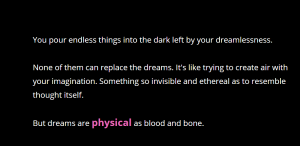
Although hypertext fiction brought the avant-garde audience to the computer in the nineties, interactive fiction brought the future gamers looking for story-driven interaction in the seventies. Despite being older, IF has actually managed to stay more relevant than hypertext fiction over the years, likely due to it being easier to approach as the player, or interactor, has more control over the story.
Scott Rettberg describes the term “interactor” in his novel Electronic Literature, which is basically a term for a person playing a piece of IF: “as the interactor moves through these environments, he or she interacts with objects and characters within the space, and those interactions determine how the story will unfold” (Rettberg, 89). Interactive fiction and hypertext fiction hold many similarities, but interaction fiction often has the goal of trying to put the interactor into the story for an immersive experience.
In order to accomplish this, a common stylistic choice of IF is second-person writing. Two examples of this are Emily Short’s “Galatea” and Porpentine’s “With Those We Love Alive”. “Galatea” is based on the Greek mythology story of Pygmalion of Cyprus, who fell in love with an ivory statue he carved, resulting in the goddess Aphrodite bringing the statue to life. In “Galatea”, the interactor talks to an android who knows little about herself and her creator other than that she is not human and, therefore, is treated differently. As the interactor, commands can be made to prompt the character to talk to Galatea, ask questions, look around the environment, and more. What is so fascinating about “Galatea” is that despite having around 70 possible endings, the entire story takes place in one room speaking to one person, Galatea. The amount of different pathways and conversations that the interactor can prompt by trying all sorts of various commands makes Galatea stand out as a prominent and influential piece of IF.
In Porpentine’s “With Those We Love Alive”, the interactor works as an artificer for an alien queen, trying to please her by crafting items for her all while exploring the palace and inserting glyphs into yourself. During my playthrough, I chose to insert the glyphs prompted and build the items requested by the queen, but there is a lot of variance in how the interactor can move the story along and choose to interact with the environment. With the addition of music and a wide range of colors, “With Those We Love Alive” is an immersive and emotional piece of IF.
What these two examples of IF have in common are their focus on story. While many pieces of IF resolve around game mechanics like puzzles, these two pieces set out to make the interactor feel something. Short’s focus on storytelling, narrative, and character arcs draws the interactor into crafting the story that they want to be told, while Porpentine’s bittersweet piece that could be read as commentary on government and more makes the interactor think carefully about every choice in customization and behavior they make.